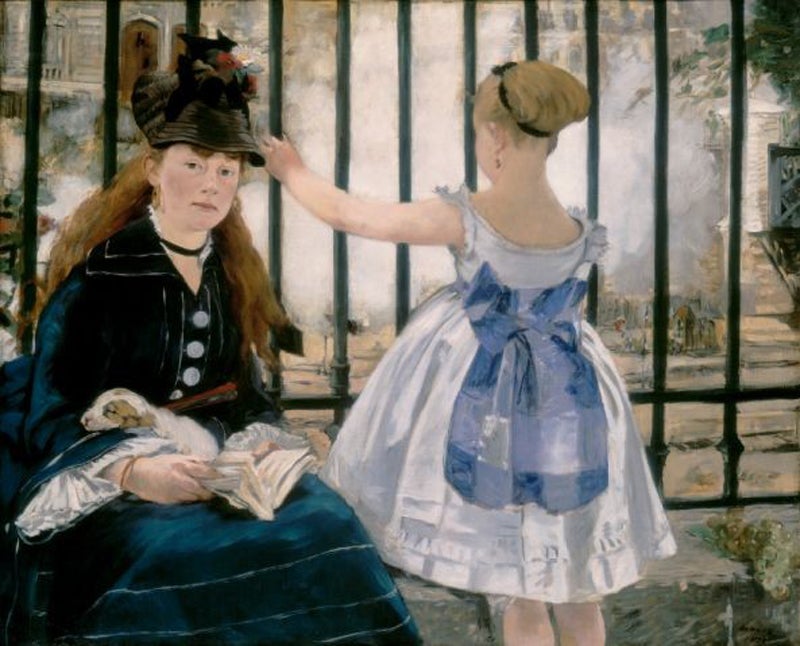Manet, Edouard: The Railway (1873)
The Independent's Great Art series

A snapshot? A train passes, leaving a cloud of steam in the air. A little girl, her back turned, stands staring at it. A young woman, sitting beside her, looks up from her book to peer out. It's a glimpse, caught one clear morning in Paris, by the railtracks outside the Gare Saint-Lazare.
Edouard Manet's The Railway acts casually. It offers no story, no clear relationship between its figures, no centre of interest. It's like a slice of uninterpreted actuality, a sight a passer-by might notice, and then forget. But not quite. This street scene is composed, and into the sort of real life incident that – mixing accident with order – sticks in the memory.
Its boldest, bluntest stroke of order is the flat-on screen of railings that runs across, going off-picture left and right and top. It divides foreground from background, forcing the figures up to the front. It lays down a repeating pattern of black stripes. Like the railway itself, it's an intrusive fact. There's no train in view, but these iron railings cut through the scene like the railway line slices through the modern city.
For some (including the little girl) they're a place to gaze at a spectacle. For others (the young woman) they're just a backdrop to everyday life. Whichever – a barrier, a threshold, a stage curtain, a ground rhythm – these railway railings are a powerful emphasising device.
The whole scene is articulated on this iron grille. It stresses the figures' opposing directions: the woman backed against it, facing keenly front; the girl turned away, faceless, looking through it into the picture's depths. Its vertical shafts cut against the curves of the girl's raised arm, and her belling skirt, and the elegant tricorn gap that forms between the figures.
The blankly simple design isolates the compact visual complexity of the young woman. She's a mass of accessories: her lap filled with cuffs, book, dog, fan, her big round buttons, her carefully spread hair, her bonnet with its floral crest. But these dense social signs are just facts, not clues. And the railings' hard, dark, grid, set against the bright dispersing steam, makes a point of maximum contrast – a keynote for a picture that is full of sharp edges and soft dissolves, of silhouettes and blurs.
The back of the girl's head and neck stands out against the billowing steam. Her elbow merges into it. One side of the woman's chin is boldly defined. The other sinks untraceably into the face. The picture has a cut-out, cartoon clarity that keeps slipping into uncertainty.
It's a scene that doesn't fix. It's a bit like a frieze. There's a hint of classical statuary in the girl's raised arm and, in the line of railings, there's a hint of a classical colonnade. But they're only hints. Manet's magic is not to insist on finding the eternal in the contemporary. It's just a subliminal resonance – now you see it, now you don't – as your eye, reading signs, making patterns, seeking meanings, plays across the indifferent row of bars.
The artist
Edouard Manet (1832-83) is a cool and elusive culture-hero. He worshipped Velazquez. He painted enigmatic but confrontational images of city life – Le Déjeuner sur l'Herbe, Olympia, A Bar at the Folies-Bergère. He continually met with rejection, scandal, and derision. Unlike other avant-gardists, he never made militant noises, nor any statement of intentions. He never stopped trying to get his work accepted. In his shortish life – he died of syphilis – he never really succeeded. But the rest is history. The Railway is on show in Art in the Age of Steam at the Walker Gallery, Liverpool .
Subscribe to Independent Premium to bookmark this article
Want to bookmark your favourite articles and stories to read or reference later? Start your Independent Premium subscription today.

Join our commenting forum
Join thought-provoking conversations, follow other Independent readers and see their replies